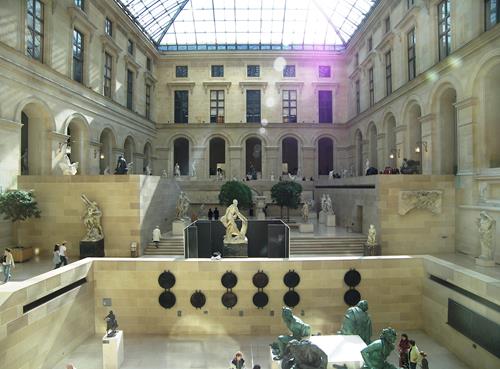
Louvre

| LOUVRE is probably a
shortened form of ‘La Louverie’, the wolf’s lair. It is not known whether this name was the king’s boast of his subjects’ complaint. Probably, knowing Parisians, the latter. The first castle here was built in 1200. Its foundations can still be visited since the new entrance tunnels to the Louvre Museum include the basement levels of all the former buildings. François I (1515-1547) knocked it down and built a nice, new, L-shaped palace. In 1563 Queen Catherine de Médicis pulled down an old tile-factory (Tuilerie) six streets away to the East and built a new palace called the Palais des Tuileries. About 1600, she noticed she was getting wet walking through the streets from her own palace to the King’s, so she began the Galerie du Bord de l’Eau to join them together. This meant a new building larger than the other two put together, since it had to be a quarter of a mile long and two stories high to bridge over the streets in between. Under Louis XIII and XIV - which means from 1610 to 1715 - The Cour Carrée multiplied the size of the original Louvre by four. At this point, Louis XIV decided the Louvre was far too small, and moved out to Versailles. The building became derelict and squatters moved in. At this stage, remember, the buildings of the Louvre were still in among the city streets. During the Revolution (1791) Louis XVI was forced to move back into the Tuileries, and then Napoleon I lived there. He added enormously to the original Art collection of François I. (It’s easy to collect Art if you’re a conquering Emperor, you just nick all the best stuff as you go along.) He had the Louvre restored to hold all this loot, and began a new gallery along his new main street, Rue de Rivoli. The job was finished by Napoleon III, who still lived in the Tuileries and let the public into the Louvre to see the Art collection. He also added two extra bits marked, designed to conceal the fact that the two long galleries aren’t parallel. The whole job was finished, and all the streets in the middle demolished, by 1865; just in time for the fall of the Empire in 1870. During the suppression of the Commune in 1871, some twit burned down the Tuileries Palace. Obviously a serendipitous twit, however, because in so doing he opened up one of the most spectacular urban views in the world, La Grande Perspective; three straight miles from the Louvre to the Arc de Triomphe, and now on another two miles to the Arch of La Défense. The Louvre continues to develop; the moat (G) at the Eastern end dates from the 1960s, when it was dug to show off the proportions of the colonnade; and at the very heart of the building is the new glass pyramid designed by I.M.Pei to form the entrance to Le Grand Louvre. Until now, the Louvre has not been all one Museum; a third of it, for example, was the Ministry of Finance. The pyramid leads to a series of underground entrances to the whole building. When the thing’s finished, there will be ten miles of galleries; not a Museum you can nip round in half an hour. There are actually six sections; Greek & Roman Antiquities, Egyptian Antiquities, Oriental Antiquities; Sculpture; Paintings; and other works of Art and furniture. |